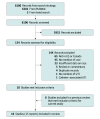Reassessment of the Role of Race in Calculating the Risk for Urinary Tract Infection: A Systematic Review and Meta-analysis
- PMID: 35435935
- PMCID: PMC9016605
- DOI: 10.1001/jamapediatrics.2022.0700
Reassessment of the Role of Race in Calculating the Risk for Urinary Tract Infection: A Systematic Review and Meta-analysis
Erratum in
-
Errors in Byline and Figure 2.JAMA Pediatr. 2022 Aug 1;176(8):829. doi: 10.1001/jamapediatrics.2022.2261. JAMA Pediatr. 2022. PMID: 35727597 Free PMC article. No abstract available.
Abstract
Importance: A previously reported prediction model included a child's race to estimate risk of urinary tract infection (UTI), but race-conscious medicine encourages investigating how race is likely to be a proxy for other factors that should instead be used for risk prediction.
Objectives: To systematically review the available literature to evaluate the robustness of the association between race and UTI and to assess whether other variables could replace race as a variable in a previously developed prediction tool without adversely affecting its accuracy.
Data source: MEDLINE was searched through May 28, 2021.
Study selection: English-language studies that reported data on the prevalence of UTI according to race for children younger than 18 years were included.
Data extraction and synthesis: Two independent reviewers assessed studies for risk of bias and abstracted data. Random-effects models were used to pool odds ratios, and meta-regression was used to explore heterogeneity.
Main outcomes and measures: Odds of UTI among non-Black children vs Black children.
Results: Sixteen studies (17 845 children) were included. In the primary analysis, which included 11 studies, the pooled odds ratio of UTI among non-Black children was 2.44-fold higher (95% CI, 1.87-3.20) than among Black children. The corresponding odds ratio in studies with low or very low risk of bias was 4.84-fold higher (95% CI, 3.16-7.41; I2 = 0%) among non-Black children than among Black children. Replacing race with history of UTI and duration of fever resulted in a model with similar accuracy (training cohort: overall sensitivity, 96% [95% CI, 94%-98%]; overall specificity, 35% [95%, 32%-38%]; overall area under the receiver operating characteristic curve, 0.80 [95% CI, 0.77-0.82]; validation cohort: overall sensitivity, 97% [95% CI, 90%-100%]; overall specificity, 32% [95% CI, 26%-37%]; overall area under the receiver operating characteristic curve, 0.84 [95% CI, 0.77-0.92]).
Conclusions and relevance: Although previous studies suggested that an association between race and UTI exists, because of the issues associated with the inclusion of race in decision models, we replaced the variable of race with history of UTI and duration of fever in a previously developed risk prediction model and found similar accuracy.
Conflict of interest statement
Figures


References
-
- Roberts KB; Subcommittee on Urinary Tract Infection, Steering Committee on Quality Improvement and Management . Urinary tract infection: clinical practice guideline for the diagnosis and management of the initial UTI in febrile infants and children 2 to 24 months. Pediatrics. 2011;128(3):595-610. doi:10.1542/peds.2011-1330 - DOI - PubMed
Publication types
MeSH terms
Grants and funding
LinkOut - more resources
Full Text Sources
Medical

